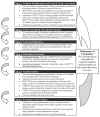Adaptation of EPEC-EM Curriculum in a Residency with Asynchronous Learning
- PMID: 21293772
- PMCID: PMC3027445
Adaptation of EPEC-EM Curriculum in a Residency with Asynchronous Learning
Abstract
Objective: The Education in Palliative and End-of-life Care for Emergency Medicine Project (EPEC™-EM) is a comprehensive curriculum in palliative and end-of-life care for emergency providers. We assessed the adaptation of this course to an EM residency program using synchronous and asynchronous learning.
Methods: Curriculum adaptation followed Kern's standardized six-step curriculum design process. Post-graduate year (PGY) 1-4 residents were taught all EPEC™-EM cognitive domains, divided as seven synchronous and seven asynchronous modules. All synchronous modules featured large group didactic lectures and review of EPEC™-EM course materials. Asynchronous modules use only EPEC™-EM electronic course media for resident self-study. Targeted evaluation for EPEC™-EM knowledge objectives was conducted by a prospective case-control crossover study, with synchronous learning serving as the quasi-control, using validated exam tools. We compared de-identified test scores for effectiveness of learning method, using aggregate group performance means for each learning strategy.
Results: Of 45 eligible residents 55% participated in a pre-test for local needs analysis, and 78% completed a post-test to measure teaching method effect. Post-test scores improved across all EPEC™-EM domains, with a mean improvement for synchronous modules of +28% (SD=9) and a mean improvement for asynchronous modules of +30% (SD=18). The aggregate mean difference between learning methods was 1.9% (95% CI -15.3, +19.0). Mean test scores of the residents who completed the post-test were: synchronous modules 77% (SD=12); asynchronous modules 83% (SD=13); all modules 80% (SD=12).
Conclusion: EPEC™-EM adapted materials can improve resident knowledge of palliative medicine domains, as assessed through validated testing of course objectives. Synchronous and asynchronous learning methods appear to result in similar knowledge transfer, feasibly allowing some course content to be effectively delivered outside of large group lectures.
Figures
Similar articles
-
Management of Poisoned Patients: Implementing a Blended Toxicology Curriculum for Emergency Medicine Residents.J Educ Teach Emerg Med. 2022 Apr 15;7(2):C1-C32. doi: 10.21980/J8C937. eCollection 2022 Apr. J Educ Teach Emerg Med. 2022. PMID: 37465448 Free PMC article.
-
An Asynchronous Curriculum: Learner Perspectives on Incorporating Asynchronous Learning Into In-Person and Virtual Emergency Residency Didactics.Cureus. 2023 Apr 27;15(4):e38188. doi: 10.7759/cureus.38188. eCollection 2023 Apr. Cureus. 2023. PMID: 37252480 Free PMC article.
-
Development and implementation of an asynchronous emergency medicine residency curriculum using a web-based platform.Intern Emerg Med. 2016 Dec;11(8):1115-1120. doi: 10.1007/s11739-016-1418-6. Epub 2016 Mar 7. Intern Emerg Med. 2016. PMID: 26951187
-
Pediatric emergency medicine asynchronous e-learning: a multicenter randomized controlled Solomon four-group study.Acad Emerg Med. 2014 Aug;21(8):912-9. doi: 10.1111/acem.12434. Epub 2014 Aug 24. Acad Emerg Med. 2014. PMID: 25154469 Clinical Trial.
-
Blended e-learning and certification for medicines development professionals: results of a 7-year collaboration between King's College, London and the GMDP Academy, New York.Front Pharmacol. 2024 Jun 19;15:1417036. doi: 10.3389/fphar.2024.1417036. eCollection 2024. Front Pharmacol. 2024. PMID: 38966556 Free PMC article. Review.
Cited by
-
Primary palliative care education in emergency medicine residency: A mixed-methods analysis of a yearlong, multimodal intervention.AEM Educ Train. 2022 Dec 20;6(6):e10823. doi: 10.1002/aet2.10823. eCollection 2022 Dec. AEM Educ Train. 2022. PMID: 36562021 Free PMC article.
-
Assessing the Acceptability and Feasibility of Leveraging Emergency Department Social Workers' Advanced Communication Skills to Assess Elderly Patients' Goals and Values.J Palliat Med. 2023 Apr;26(4):517-526. doi: 10.1089/jpm.2022.0136. Epub 2022 Dec 22. J Palliat Med. 2023. PMID: 36576866 Free PMC article. Clinical Trial.
-
Individualized Interactive Instruction: A Guide to Best Practices from the Council of Emergency Medicine Residency Directors.West J Emerg Med. 2019 Mar;20(2):363-368. doi: 10.5811/westjem.2018.12.40059. Epub 2019 Feb 11. West J Emerg Med. 2019. PMID: 30881558 Free PMC article. Review.
-
[Palliative aspects in clinical acute and emergency medicine as well as intensive care medicine : Consensus paper of the DGIIN, DGK, DGP, DGHO, DGfN, DGNI, DGG, DGAI, DGINA and DG Palliativmedizin].Med Klin Intensivmed Notfmed. 2023 Dec;118(Suppl 1):14-38. doi: 10.1007/s00063-023-01016-9. Epub 2023 Jun 7. Med Klin Intensivmed Notfmed. 2023. PMID: 37285027 Free PMC article. Review. German.
-
Communication Training and Code Status Conversation Patterns Reported by Emergency Clinicians.J Pain Symptom Manage. 2023 Jan;65(1):58-65. doi: 10.1016/j.jpainsymman.2022.10.006. Epub 2022 Oct 17. J Pain Symptom Manage. 2023. PMID: 36265695 Free PMC article.
References
-
- US Department of HHS, CDC. Births, marriages, divorces, and deaths: provisional data for 2007. National Vital Statistics Reports. 2008;56(21):1–3. - PubMed
-
- Ly N, McCaig LF. National hospital ambulatory medical care survey: 2000 outpatient department summary. Adv Data. 2002;(327):1–27. - PubMed
-
- Field MJ, Cassel CK, editors. for Institute of Medicine. Approaching Death: Improving Care at the End of Life. Washington, DC: National Academy Press; 1997. - PubMed


